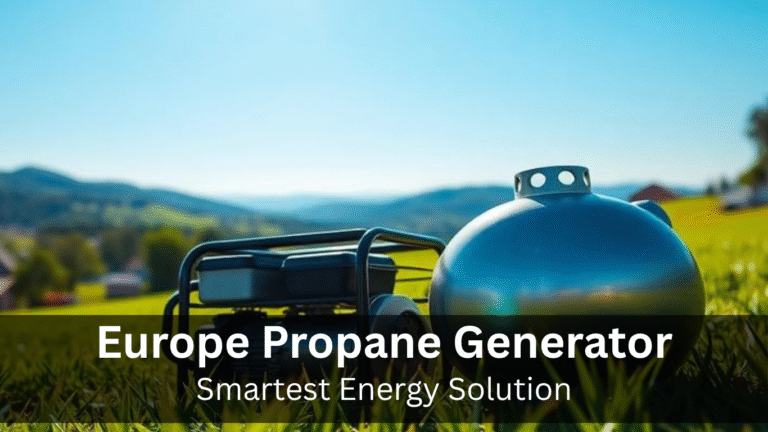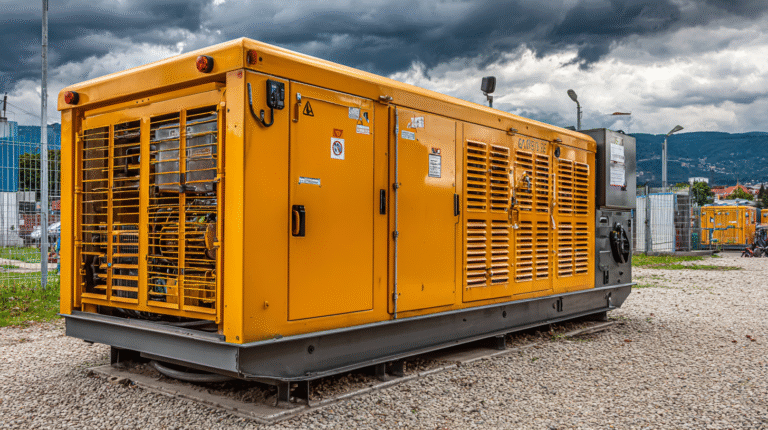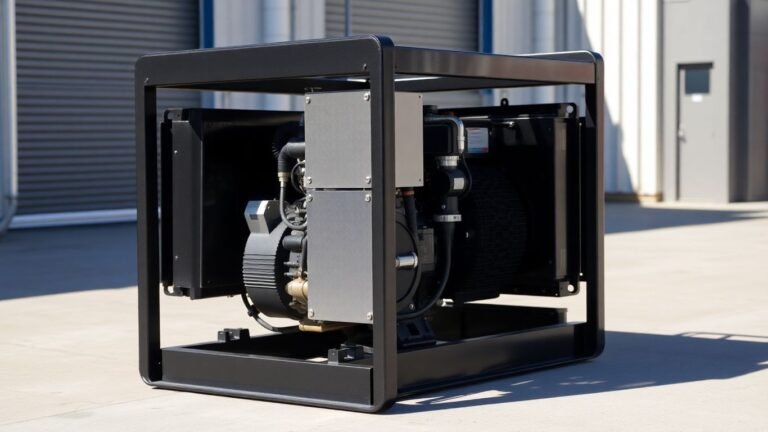Diesel Generator Sizes Explained: How to Choose the Right One for Your Needs
Picking out the right diesel generator can feel like a big deal, right? There are so many options, and it’s easy to get confused about what you actually need. You don’t want to end up with something too small that can’t handle your stuff, but you also don’t want to blow a bunch of money on a giant machine you don’t really need. This article is all about helping you figure out the perfect diesel generator sizes for your specific situation, so you can make a smart choice without all the headaches.
Key Takeaways
- Always figure out your total power needs before looking at diesel generator sizes.
- Consider if you need single-phase or three-phase power, as this impacts generator type.
- Don’t forget to account for the extra power needed to start certain appliances.
- A slightly larger diesel generator can actually last longer and be more reliable.
- Sometimes using multiple smaller generators together is better than one huge one.
Understanding Diesel Generator Classes

When you’re looking at diesel generators, it’s not just about picking a random size. You really need to get a handle on the different classes out there. It’s kind of like buying a car; you wouldn’t just pick any car, right? You’d think about whether you need a compact for city driving or a big SUV for hauling stuff. Generators are similar. Knowing the class helps you narrow down your options and make sure you’re getting something that actually fits what you need it for.
Residential Diesel Generator Sizes
For homes, you’re usually looking at smaller generators. These are designed to kick in when the power goes out, keeping your fridge running, maybe some lights, and a few other important things. They aren’t meant to power your whole house like normal, but they’ll keep things from going completely dark. Most residential units are in the 5 kW to 20 kW range, which is enough for basic backup power. You might see some portable ones that are even smaller, good for camping or a few tools. Stationary residential generators are usually hooked up to your home’s electrical system and turn on automatically when they sense an outage. They’re pretty quiet compared to the big industrial ones, and they don’t take up a ton of space.
Industrial Diesel Generator Sizes
Now, industrial generators are a whole different beast. These are for businesses, factories, hospitals, and other places that absolutely cannot lose power, even for a second. We’re talking about units that can power entire buildings or even small towns. They’re built to run for long periods, sometimes continuously, and they’re much more robust than residential models. You’ll find these in sizes ranging from 50 kW all the way up to several megawatts. They’re loud, they’re big, and they need a lot of fuel. They also need regular maintenance to keep them running smoothly. Think about a hospital; they need to keep life support machines going, so a tiny residential generator just won’t cut it. These larger units often have advanced control systems and can be monitored remotely.
Choosing the right class of generator is a big deal. If you pick one that’s too small, you won’t have enough power when you need it most. If you go too big, you’re wasting money on something you don’t fully use, and it might even cause problems for the generator itself by not running at its optimal load. It’s a balance, and understanding these classes is the first step to getting it right.
Single-Phase Versus Three-Phase Power
This is where things get a bit technical, but it’s important. Power comes in different forms, and generators are built to produce one or the other. Generator set labels will tell you what kind of power they produce.
- Single-Phase Power: This is what you have in your home. It’s typically 120V or 240V and is used for most household appliances, lights, and smaller motors. Residential generators almost always produce single-phase power. It’s simpler and cheaper to set up.
- Three-Phase Power: This is what industrial and commercial buildings use. It’s more efficient for powering large motors, heavy machinery, and big electrical systems. You’ll see voltages like 208V, 480V, or even higher. Industrial generators are almost always three-phase. If you try to run three-phase equipment on a single-phase generator, it just won’t work, or it’ll damage the equipment. It’s like trying to fit a square peg in a round hole.
Understanding whether you need single-phase or three-phase power is a critical step in selecting the correct generator. Most homes only need single-phase, but if you’re running a workshop with heavy machinery, you’ll likely need three-phase. Always check the power requirements of the equipment you plan to run before making a decision.

Calculating Your Diesel Generator Size Needs
Figuring out the right diesel generator sizes and power output can feel a bit like solving a puzzle, but it’s super important to get it right. You don’t want to end up with something too small that can’t handle your needs, or something way too big that just wastes money. This section will walk you through how to determine what size diesel generator do I need, making sure you pick the perfect fit for your home or business.
Assessing Total Wattage Requirements
First things first, you need to make a list of everything you plan to power with your diesel generator. This isn’t just a casual mental note; you need to be thorough. Go through your house or business and jot down every single appliance, light, and piece of equipment that absolutely needs to run during a power outage. Once you have your list, find the wattage for each item. This information is usually on a label on the appliance itself, or in its owner’s manual. Add all these wattages together to get your total running wattage. This sum is your baseline for sizing a diesel generator.
It’s easy to underestimate your power needs, but a little extra time spent on this step can save you a lot of headaches later. Being precise here is key to a successful diesel generator sizing guide.
Factoring In Starting Versus Running Wattage
This is where things get a little tricky, but it’s a crucial part of diesel generator sizing. Many appliances, especially those with motors like refrigerators, air conditioners, or power tools, require a much higher surge of power to start up than they do to keep running. This initial surge is called starting wattage, and it can be several times higher than the running wattage. If your generator can’t handle this starting surge, those appliances simply won’t turn on, or worse, it could trip the generator’s breaker. Always account for the highest starting wattage of any single appliance you plan to run simultaneously.
Here’s a quick example:
- Refrigerator: Running Wattage: 800W, Starting Wattage: 2400W
- Microwave: Running Wattage: 1500W, Starting Wattage: 1500W (no surge)
- Well Pump: Running Wattage: 1000W, Starting Wattage: 3000W
When calculating your total, you’d add up all the running wattages, then identify the single highest starting wattage among your appliances and add that to your total. This gives you the peak power demand your generator needs to meet.
Converting Kilowatts To Kilovolt-Amperes
Once you have your total wattage, which is typically in kilowatts (kW), you’ll often see diesel generators rated in kilovolt-amperes (kVA). This is where the diesel generator kVA calculation comes in. The difference between kW and kVA has to do with something called the power factor. Without getting too technical, kVA is the apparent power, while kW is the actual power being used. Most diesel generators have a power factor of 0.8. To convert kW to kVA, you divide your total kW by the power factor (0.8).
For example, if your total calculated power requirement is 20 kW:
- 20 kW / 0.8 = 25 kVA
So, you would need a generator with at least 25 kVA capacity. This conversion is vital for understanding diesel generator capacity guide and ensuring you pick the right unit. You can find more help with generator sizing calculators if you need it.

Optimizing Diesel Generator Performance
Defining Running Requirements
When you’re picking out a diesel generator, it’s super important to think about how you’ll actually use it. Is this thing going to be your main power source, running day in and day out, or is it just for emergencies when the grid goes down? Knowing your running requirements helps you pick a generator that can handle the load without breaking a sweat. If it’s for continuous use, you really shouldn’t run it at its absolute maximum capacity for long periods. Most experts suggest aiming for about 70-80% of its capacity for regular, ongoing operation. This gives you a nice buffer and helps keep the generator healthy for longer. Think of it like driving your car; you wouldn’t redline it everywhere you go, right? Same idea here.
- Primary Power Source: If the generator is your main power, size it so it runs at 70-80% of its capacity. This prevents wear and tear.
- Standby/Emergency Use: For occasional use, you might be able to push it closer to full capacity for short bursts, but it’s still good to have some wiggle room.
- Load Fluctuation: Consider if your power needs will vary a lot. A generator that can handle peaks and valleys without constant strain is ideal.
Considering Site Conditions And Access
Once you’ve got a handle on your power needs, the next big thing is where this generator is actually going to live. Site conditions and access are a huge deal, and they can definitely impact the size and type of generator you can even get. You might have the perfect generator picked out on paper, but if you can’t get it to your site, or if there’s no room for it, then what? Things like narrow roads, steep inclines, or even just tight turns can make delivering a large generator a nightmare. And once it’s there, does it fit? Is there enough space for proper ventilation and maintenance? These practical considerations are just as important as the technical specs.
It’s easy to get caught up in the numbers, but the physical reality of your site can be a major limiting factor. Always do a thorough site assessment before finalizing your generator choice. This includes looking at the ground, potential obstacles, and how much space you have for the unit itself, plus any necessary fuel tanks or exhaust systems.
Allowing For Future Power Requirements
Nobody wants to buy a generator only to find out a year later it’s too small. It’s a good idea to think about your future power needs when you’re sizing a generator. Are you planning to expand your business? Add more equipment to your home? Maybe you’re thinking about an electric vehicle charger down the line. Building in a little extra capacity now can save you a lot of headaches and money later. It’s like buying a slightly bigger coat for a growing kid – it might be a bit roomy now, but it’ll fit perfectly soon enough. This foresight helps extend generator lifespan and avoids the need for costly upgrades or even a complete replacement down the road.
Here’s why planning for the future is smart:
- Avoids premature replacement: A slightly oversized generator can accommodate growth without needing to be swapped out.
- Handles unexpected additions: You never know what new appliance or system you might need in the future.
- Maintains efficiency: A generator running comfortably within its capacity, even with future additions, will generally operate more efficiently than one constantly pushed to its limits.

Benefits Of Choosing The Right Diesel Generator Size
Getting the right size diesel generator isn’t just about having power; it’s about having the right power. It’s like picking out shoes – too big, and you’re tripping; too small, and your feet hurt. The same goes for generators. Matching your generator’s output to your actual power needs is key for smooth operation and long-term savings. This is especially true when you’re looking at portable vs industrial diesel generators, where the stakes are much higher for industrial applications.
Preventing Damage To Appliances And Devices
When your generator is too small for the job, it struggles. Imagine trying to run a marathon with a sprained ankle – it’s just not going to work well. An undersized generator will constantly be pushed to its limits, leading to voltage drops and inconsistent power delivery. This can seriously mess with your sensitive electronics and appliances. They might not get enough power to run correctly, or they could experience surges when the generator tries to catch up, both of which can cause damage over time. It’s a common issue when people are selecting diesel generator power without fully understanding their load.
Choosing the correct generator size is a proactive step in safeguarding your valuable equipment. It ensures a stable and consistent power flow, preventing the kind of electrical stress that can lead to premature failure of appliances and sensitive electronics. It’s an investment in protection.
Extending Diesel Generator Lifespan
Just like any machine, a generator has a sweet spot for operation. Running it constantly at maximum capacity, or worse, overloading it, is a surefire way to shorten its life. Think of it like driving your car with the pedal to the metal all the time – eventually, something’s going to give. An appropriately sized generator will operate efficiently, without undue strain on its engine and components. This means less wear and tear, fewer breakdowns, and ultimately, a much longer service life for your investment. It’s about finding that balance where the generator works hard but not too hard.
Ensuring Consistent Power Supply
What’s the point of having a generator if it can’t reliably provide power when you need it? An undersized unit might trip breakers, shut down unexpectedly, or simply fail to start certain high-demand appliances. This leads to frustrating interruptions and can be a real problem for businesses or critical home systems. A correctly sized generator, however, can handle your peak loads without breaking a sweat, providing a steady and dependable power supply. This reliability is crucial for everything from keeping your lights on during an outage to maintaining continuous operations in an industrial setting. It’s about peace of mind, knowing your power needs are covered.
Why Oversizing Your Diesel Generator Is Beneficial
When you’re picking out a diesel generator, it might seem like a good idea to get one that just barely covers your power needs. You know, save a few bucks. But actually, going a bit bigger, or “oversizing,” can really pay off in the long run. It’s not about wasting money; it’s about making sure your power setup is robust and reliable. Think of it like buying a car with a slightly bigger engine than you think you need – it handles unexpected hills and extra passengers without breaking a sweat.
Increased Usable Life Of The Generator
Running a generator at its absolute maximum capacity all the time is like redlining your car’s engine every single drive. It’s just not good for it. When you oversize your generator, you’re giving it some breathing room. It doesn’t have to work as hard to meet your power demands, which means less wear and tear on its internal components. This reduced strain directly translates to a longer operational life for the generator. It’s simple mechanics: less stress equals more years of service. This also means fewer breakdowns and less money spent on repairs or early replacements. For example, if you consistently run a generator at 70-80% of its capacity instead of 90-100%, you’ll see a noticeable difference in how long it lasts.
Reduced Risk Of Overburdening
Imagine you’ve got a generator that’s perfectly sized for your current needs. What happens when you add a new piece of equipment, or maybe your business expands a little? If your generator is already running at its limit, that new load could push it over the edge. An overburdened generator can lead to all sorts of problems, from tripping breakers to outright failure. It can also damage the appliances and devices connected to it because of inconsistent power delivery. By oversizing, you build in a safety margin. This buffer means your generator can handle unexpected surges or additional loads without getting stressed out. It’s like having a bigger fuse than you strictly need – it prevents the whole system from shutting down when there’s a slight spike. This is especially important for optimizing generator size in critical applications where power interruptions are not an option.
Having a generator that’s slightly larger than your immediate needs provides a crucial safety net. It ensures that your power supply remains stable and reliable, even when unforeseen demands arise. This proactive approach prevents costly downtime and protects your valuable equipment from potential damage caused by an inadequate power source.
Accommodation For Future Power Needs
Let’s be real, things change. Your power requirements today might not be your power requirements a year from now. Maybe you’ll add more machinery, expand your home, or simply acquire more power-hungry gadgets. If you’ve got a generator that’s just barely cutting it now, you’ll be in a tough spot when those future needs pop up. You’ll either have to buy a whole new, bigger generator (which is expensive and a hassle) or try to make do with an undersized one, risking all the problems we just talked about. Oversizing from the start means you’re prepared. You’ve got the capacity built in to handle growth without needing to upgrade your entire power system. It’s a smart, forward-thinking investment that saves you headaches and money down the road. Consider these points when planning for future needs:
- Anticipate growth: Think about potential expansions in your home or business.
- New equipment: Will you be adding more appliances or machinery that draw power?
- Technology shifts: Future technologies might require more power than current ones.
- Seasonal variations: Some operations have higher power demands during certain times of the year.
The Advantages Of Paralleling Diesel Generators

When you’re looking at power solutions, especially for bigger operations, you might think a single, massive generator is the way to go. But sometimes, putting a few smaller generators together, which is called paralleling, can actually be a much smarter move. It’s like having a team instead of one superstar; if one player gets tired, the others can pick up the slack. This approach offers some pretty neat benefits that are worth considering.
Greater Operational Flexibility
One of the biggest perks of paralleling generators is the flexibility it gives you. Imagine you have one huge generator, and it needs maintenance or, heaven forbid, it breaks down. Everything stops. But if you have two or three smaller ones running in parallel, you can take one offline for service without shutting down your whole operation. The other units can keep things humming along, maybe at a slightly reduced capacity, but still running. This ability to maintain power even when one unit is down is a game-changer for reliability. It means less downtime and fewer headaches for you. Plus, you can adjust your power output more precisely. If your power needs fluctuate throughout the day, you can run fewer generators during low-demand periods, saving on fuel and wear and tear.
Potential Cost-Effectiveness
It might seem counterintuitive, but sometimes, buying several smaller generators can actually be more cost-effective than one giant one. This is especially true once you get past certain power thresholds. For example, diesel engines over 600kW and gas engines over 150kW start to get really expensive because they’re not mass-produced like smaller engines. The engine is a huge chunk of the generator’s cost, so if you can use more common, smaller engines, you might save a good bit of money. Of course, this depends on a lot of factors like the specific brands, whether you’re buying new or used, and where you’re located. But it’s definitely something to look into.
While the initial thought might be that bigger is always better, the economics of generator manufacturing often favor multiple smaller units over a single, very large one, particularly when considering the cost of specialized, high-capacity engines.
Easier Physical Integration
Another practical advantage of paralleling is how much easier it can be to fit the equipment into your space. A single, very large commercial generator can take up a surprising amount of room—we’re talking 25 square feet or more difference compared to smaller units. If you’re working with limited space, or if your building has tricky layouts, trying to shoehorn in one massive generator might be a nightmare. Two or three smaller units, on the other hand, can often be placed in different spots, or configured in a way that makes better use of the available area. This can be a huge benefit for generator installation and overall site planning. It’s not just about the footprint either; think about access for maintenance. It’s often simpler to work around smaller machines than one giant behemoth.
Conclusion
Picking the right diesel generator size might seem like a big deal, but it doesn’t have to be. Just remember to figure out what you need to power, how much juice those things actually use, and where the generator will sit. Doing a little homework upfront means you’ll get a generator that works for you, without spending too much or ending up with something too small. It’s all about being prepared, so when the lights go out, you’re ready.
Frequently Asked Questions
How do I figure out what size diesel generator I need?
The ideal size of your diesel generator depends on what you need to power. First, list all the items you plan to run. Then, find out the starting and running power (in watts) for each item. Add these up to get your total power needs. It’s always a good idea to chat with an electrician to make sure you pick the perfect size.
How does a diesel generator actually work?
A diesel generator works by burning diesel fuel to turn an engine, which then spins a part called an alternator. This spinning creates electricity. The electricity then flows through wires to power your home or business.
Can a diesel generator power my whole house?
Yes, you can! Many diesel generators are designed to provide backup power for homes. They can automatically turn on when the main power goes out and turn off when it comes back on. This keeps your lights and appliances running smoothly.
How much fuel does a diesel generator use?
The amount of fuel a diesel generator uses depends on its size and how much power it’s putting out. A bigger generator or one running at full power will use more fuel. You can often find charts or guides that estimate fuel use for different generator sizes.
Do diesel generators need a lot of maintenance?
While diesel generators are very reliable, they do need some care. This includes checking the oil, fuel, and air filters regularly, and making sure the battery is charged. Following the manufacturer’s instructions for maintenance will help your generator last a long time.
How long do diesel generators typically last?
Diesel generators are known for being tough and lasting a long time, often many thousands of hours of use. How long one lasts depends on how well it’s maintained, how often it’s used, and the conditions it operates in. Proper care can significantly extend its life.









13 Comments